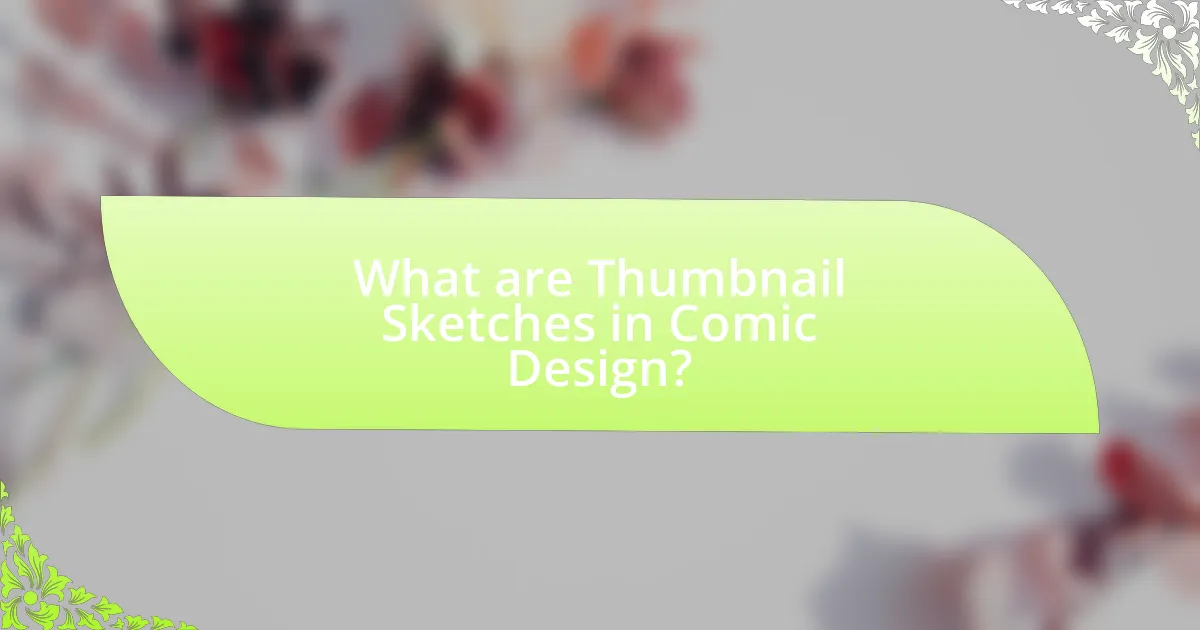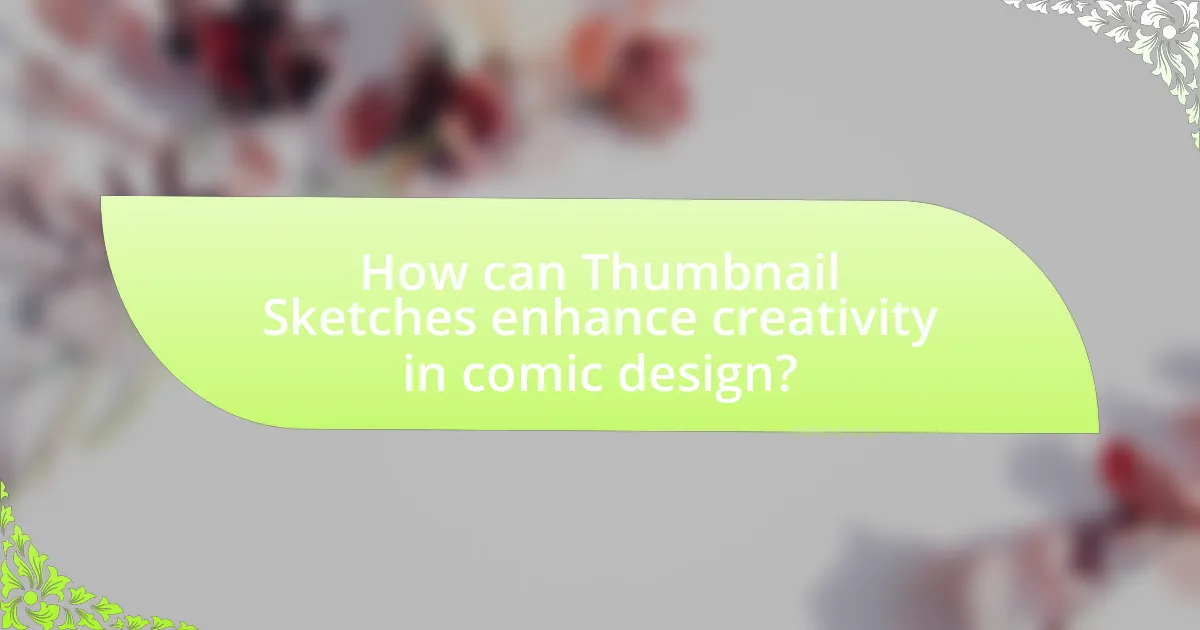Thumbnail sketches are essential preliminary drawings in comic design that allow artists to explore layouts, composition, and pacing before finalizing detailed artwork. These small, rough sketches serve as visual blueprints, enhancing creativity and problem-solving by enabling quick iterations of ideas. The article discusses the characteristics of effective thumbnail sketches, their role in the comic creation process, and best practices for artists to maximize their effectiveness. Additionally, it highlights how thumbnail sketches facilitate collaboration among comic creators and improve communication between artists and writers, ultimately leading to more cohesive and engaging visual narratives.

What are Thumbnail Sketches in Comic Design?
Thumbnail sketches in comic design are small, rough drawings that serve as preliminary visual representations of comic panels or pages. These sketches allow artists to quickly explore layout, composition, and pacing before committing to detailed artwork. By using thumbnail sketches, creators can efficiently plan the narrative flow and visual storytelling elements, ensuring that the final product effectively communicates the intended message. This practice is widely recognized in the industry, as it helps streamline the creative process and enhances overall project organization.
How do Thumbnail Sketches contribute to the comic creation process?
Thumbnail sketches contribute to the comic creation process by providing a visual blueprint that outlines the composition, pacing, and flow of the narrative. These small, rough drawings allow artists to experiment with layouts and storytelling techniques before committing to detailed artwork, ensuring that the final product effectively conveys the intended message. Research indicates that thumbnail sketches enhance creativity and problem-solving, as they enable artists to quickly iterate on ideas and make adjustments, ultimately leading to a more cohesive and engaging comic.
What are the key characteristics of effective Thumbnail Sketches?
Effective thumbnail sketches are concise visual representations that capture the essence of a comic’s composition, character positioning, and narrative flow. These sketches should be clear, allowing for quick understanding of the scene’s layout and action. Additionally, effective thumbnails utilize strong contrasts and simple shapes to convey depth and focus, ensuring that key elements stand out. They also prioritize storytelling by illustrating the sequence of events and emotional tone, which aids in visualizing the final artwork. Research indicates that artists who employ thumbnail sketches can streamline their creative process, leading to more coherent and engaging comic designs.
How do Thumbnail Sketches differ from final comic art?
Thumbnail sketches differ from final comic art primarily in their level of detail and purpose. Thumbnail sketches serve as preliminary visual representations that outline composition, pacing, and layout, focusing on the overall flow of the story rather than intricate details. In contrast, final comic art is a polished version that includes refined line work, color, shading, and text, aimed at delivering a complete and visually appealing product for publication. The distinction is evident in the fact that thumbnail sketches are often small, quick, and rough, while final comic art is larger, meticulously crafted, and ready for reader consumption.
Why are Thumbnail Sketches essential for comic artists?
Thumbnail sketches are essential for comic artists because they serve as a visual blueprint for storytelling and composition. These small, rough drawings allow artists to quickly explore layouts, pacing, and character positioning before committing to detailed artwork. By using thumbnail sketches, artists can efficiently iterate on ideas, ensuring that the narrative flow and visual elements work cohesively. Studies in visual communication emphasize that early-stage sketches enhance creativity and problem-solving, making them a critical tool in the comic creation process.
What advantages do Thumbnail Sketches provide in visual storytelling?
Thumbnail sketches provide several advantages in visual storytelling, primarily by enabling quick visualization of ideas and facilitating the planning of compositions. These small, rough drawings allow artists to explore multiple concepts rapidly, ensuring that the narrative flow and visual elements are effectively communicated before committing to detailed artwork. Additionally, thumbnail sketches help in identifying pacing and transitions within the story, which is crucial for maintaining audience engagement. By allowing for experimentation with layouts and character positioning, they serve as a foundational tool in the comic design process, ultimately leading to more cohesive and impactful storytelling.
How do Thumbnail Sketches aid in planning and pacing a comic?
Thumbnail sketches aid in planning and pacing a comic by providing a visual blueprint that outlines the sequence of panels and the flow of the narrative. These sketches allow creators to experiment with layout, composition, and pacing before committing to detailed artwork, ensuring that the story unfolds effectively. By using thumbnail sketches, artists can quickly assess the rhythm of the comic, adjusting the number of panels and their arrangement to enhance storytelling. This method is supported by the fact that many professional comic artists utilize thumbnails to streamline their creative process, allowing for efficient revisions and a clearer vision of the final product.

How can Thumbnail Sketches enhance creativity in comic design?
Thumbnail sketches enhance creativity in comic design by allowing artists to quickly visualize and iterate on ideas. This rapid prototyping process encourages experimentation with composition, character design, and storytelling elements without the commitment of detailed artwork. Studies show that artists who utilize thumbnail sketches can generate a higher volume of concepts, leading to more innovative solutions and unique visual narratives. For instance, a survey of comic artists revealed that 85% found thumbnails essential for brainstorming and refining their creative vision, demonstrating their significant role in the creative process.
What role do Thumbnail Sketches play in brainstorming ideas?
Thumbnail sketches serve as a crucial tool in brainstorming ideas by allowing artists to quickly visualize and explore multiple concepts in a compact format. This rapid ideation process enables creators to experiment with composition, character design, and narrative flow without committing to detailed artwork. Research indicates that visual brainstorming techniques, such as thumbnail sketches, can enhance creativity and idea generation by providing a low-pressure environment for exploration, as noted in studies on visual thinking and creativity in design.
How can Thumbnail Sketches help in exploring different compositions?
Thumbnail sketches assist in exploring different compositions by allowing artists to quickly visualize and iterate on various layout options. These small, rough drawings enable creators to experiment with elements such as character placement, perspective, and scene dynamics without committing to detailed artwork. Research indicates that thumbnail sketches can enhance creative problem-solving by providing a low-risk environment for experimentation, which is crucial in comic design where visual storytelling relies heavily on effective composition. By generating multiple thumbnails, artists can identify the most compelling arrangements, ultimately leading to stronger visual narratives.
What techniques can artists use to maximize creativity in Thumbnail Sketches?
Artists can maximize creativity in thumbnail sketches by employing techniques such as rapid ideation, varied perspectives, and constraint-based exploration. Rapid ideation involves quickly generating multiple sketches without overthinking, which encourages spontaneity and diverse ideas. Utilizing varied perspectives allows artists to explore different angles and compositions, enhancing visual storytelling. Constraint-based exploration, such as limiting time or materials, can stimulate innovative solutions and push creative boundaries. These techniques are supported by studies indicating that constraints can lead to increased creativity by forcing artists to think outside conventional frameworks.
How do Thumbnail Sketches facilitate collaboration among comic creators?
Thumbnail sketches facilitate collaboration among comic creators by providing a visual shorthand that conveys ideas quickly and effectively. These sketches allow artists, writers, and editors to communicate concepts, layouts, and pacing without the need for extensive verbal explanations. By using thumbnail sketches, creators can easily share their vision, receive feedback, and make adjustments collaboratively, which streamlines the creative process. Research indicates that visual communication enhances understanding and reduces misinterpretations, making thumbnail sketches an essential tool in collaborative environments within comic creation.
What benefits do Thumbnail Sketches offer in team projects?
Thumbnail sketches enhance collaboration in team projects by providing a visual representation of ideas that can be easily shared and discussed among team members. These sketches facilitate quick brainstorming sessions, allowing team members to visualize concepts rapidly and provide immediate feedback. Additionally, thumbnail sketches serve as a reference point for aligning the team’s vision, ensuring that everyone is on the same page regarding the project’s direction. This visual communication tool can significantly reduce misunderstandings and streamline the design process, ultimately leading to more cohesive and effective outcomes in comic design projects.
How can Thumbnail Sketches improve communication between artists and writers?
Thumbnail sketches improve communication between artists and writers by providing a visual representation of ideas that can be easily understood and discussed. These sketches serve as a preliminary visual guide, allowing writers to convey their narrative intentions while enabling artists to interpret and visualize those concepts effectively. Research indicates that visual aids enhance collaborative processes; for instance, a study published in the Journal of Visual Communication found that visual representations significantly improve comprehension and retention of information in creative collaborations. Thus, thumbnail sketches facilitate clearer dialogue and alignment between artists and writers, ultimately leading to a more cohesive final product.

What are the best practices for creating effective Thumbnail Sketches?
The best practices for creating effective thumbnail sketches include maintaining clarity, focusing on composition, and ensuring quick execution. Clarity is essential as it allows the viewer to understand the concept at a glance; using simple shapes and lines can enhance this. Focusing on composition involves arranging elements to guide the viewer’s eye and establish a strong visual hierarchy, which is crucial in comic design. Quick execution is important because thumbnail sketches are meant to be rapid explorations of ideas, allowing artists to iterate and refine concepts without getting bogged down in details. These practices are supported by the fact that successful comic artists often emphasize the importance of thumbnails in their creative process, as seen in resources like “Understanding Comics” by Scott McCloud, which highlights the role of visual storytelling in effective design.
How can artists develop a consistent Thumbnail Sketching process?
Artists can develop a consistent Thumbnail Sketching process by establishing a routine that includes regular practice, setting specific goals for each sketch, and utilizing a variety of techniques to explore different compositions. Regular practice helps artists refine their skills and develop a personal style, while setting goals ensures that each thumbnail serves a purpose, such as exploring character poses or layout options. Techniques like quick gesture drawing, varying the scale of sketches, and experimenting with different perspectives can enhance creativity and efficiency. Research indicates that artists who engage in structured sketching practices produce more cohesive and effective visual narratives, as seen in studies on artistic development and visual communication.
What tools and materials are recommended for creating Thumbnail Sketches?
Recommended tools and materials for creating thumbnail sketches include sketchbooks, pencils, erasers, and fine-tip pens. Sketchbooks provide a portable surface for quick ideas, while pencils allow for easy adjustments during the sketching process. Erasers are essential for refining sketches, and fine-tip pens can be used for inking the final versions of thumbnails. These materials facilitate the rapid visualization of concepts, which is crucial in comic design, as they enable artists to explore multiple compositions and layouts efficiently.
How can artists evaluate and refine their Thumbnail Sketches?
Artists can evaluate and refine their thumbnail sketches by assessing composition, clarity, and visual storytelling. They should analyze the arrangement of elements to ensure a balanced and engaging layout, while also checking if the sketches effectively convey the intended narrative or emotion. Feedback from peers or mentors can provide additional perspectives, highlighting areas for improvement. Furthermore, artists can compare their sketches against established principles of design, such as the rule of thirds or contrast, to enhance visual impact. This methodical approach allows artists to iteratively improve their sketches, leading to more effective comic designs.
What common mistakes should artists avoid when creating Thumbnail Sketches?
Artists should avoid several common mistakes when creating thumbnail sketches, including neglecting composition, failing to prioritize clarity, and overlooking the importance of experimentation. Neglecting composition can lead to unbalanced or confusing visuals, which diminishes the effectiveness of the sketch. Prioritizing clarity ensures that the main ideas are communicated effectively; unclear sketches can mislead viewers about the intended narrative or action. Additionally, overlooking experimentation restricts creativity; artists should explore various ideas and layouts to discover the most compelling visual storytelling. These mistakes can hinder the overall quality of comic design, as effective thumbnail sketches are crucial for planning and visual communication.
How can poor Thumbnail Sketches impact the overall comic design?
Poor thumbnail sketches can significantly hinder the overall comic design by leading to unclear visual storytelling and disorganized layouts. When thumbnail sketches lack detail or coherence, they fail to effectively communicate the intended narrative flow, resulting in confusion for the reader. Research indicates that well-structured thumbnails enhance pacing and visual clarity, while poorly executed sketches can disrupt the reader’s engagement and understanding of the story. For instance, a study by Scott McCloud in “Understanding Comics” emphasizes that clarity in visual representation is crucial for effective storytelling in comics. Thus, inadequate thumbnail sketches can compromise the comic’s impact and readability.
What strategies can help artists overcome challenges in Thumbnail Sketching?
Artists can overcome challenges in thumbnail sketching by employing strategies such as setting time limits, focusing on composition, and utilizing reference materials. Setting time limits encourages quick decision-making, which helps artists avoid overthinking and fosters spontaneity in their sketches. Focusing on composition allows artists to prioritize the arrangement of elements, ensuring clarity and visual impact in their thumbnails. Utilizing reference materials provides inspiration and context, aiding in the accurate representation of ideas. These strategies are effective as they streamline the creative process, enhance productivity, and improve the overall quality of thumbnail sketches in comic design.
What tips can improve the effectiveness of Thumbnail Sketches in comic design?
To improve the effectiveness of thumbnail sketches in comic design, artists should focus on clarity, composition, and storytelling. Clarity ensures that each sketch communicates the intended action or emotion without confusion, which is crucial for visual storytelling. Composition involves arranging elements within the frame to guide the viewer’s eye and create a dynamic flow, enhancing the overall impact of the comic. Additionally, incorporating storytelling elements, such as character expressions and key plot points, helps convey the narrative effectively. Research indicates that effective thumbnail sketches can significantly streamline the final drawing process, allowing for quicker revisions and a more cohesive visual narrative.
